+ Open data
Open data
- Basic information
Basic information
| Entry | Database: PDB / ID: 7dmc | ||||||
|---|---|---|---|---|---|---|---|
| Title | Dipyridamole binds to the N-terminal domain of human Hsp90A | ||||||
 Components Components | Heat shock protein HSP 90-alpha Heat shock response Heat shock response | ||||||
 Keywords Keywords |  CHAPERONE / ATP binding domain / CHAPERONE / ATP binding domain /  Hsp90 / Hsp90 /  Dipyridamole Dipyridamole | ||||||
| Function / homology |  Function and homology information Function and homology informationsperm mitochondrial sheath /  dATP binding / Scavenging by Class F Receptors / dATP binding / Scavenging by Class F Receptors /  sulfonylurea receptor binding / CTP binding / positive regulation of protein polymerization / vRNP Assembly / UTP binding / sperm plasma membrane / positive regulation of tau-protein kinase activity ...sperm mitochondrial sheath / sulfonylurea receptor binding / CTP binding / positive regulation of protein polymerization / vRNP Assembly / UTP binding / sperm plasma membrane / positive regulation of tau-protein kinase activity ...sperm mitochondrial sheath /  dATP binding / Scavenging by Class F Receptors / dATP binding / Scavenging by Class F Receptors /  sulfonylurea receptor binding / CTP binding / positive regulation of protein polymerization / vRNP Assembly / UTP binding / sperm plasma membrane / positive regulation of tau-protein kinase activity / protein insertion into mitochondrial outer membrane / sulfonylurea receptor binding / CTP binding / positive regulation of protein polymerization / vRNP Assembly / UTP binding / sperm plasma membrane / positive regulation of tau-protein kinase activity / protein insertion into mitochondrial outer membrane /  chaperone-mediated autophagy / chaperone-mediated autophagy /  telomerase holoenzyme complex assembly / Rho GDP-dissociation inhibitor binding / Uptake and function of diphtheria toxin / mitochondrial transport / Drug-mediated inhibition of ERBB2 signaling / Resistance of ERBB2 KD mutants to trastuzumab / Resistance of ERBB2 KD mutants to sapitinib / Resistance of ERBB2 KD mutants to tesevatinib / Resistance of ERBB2 KD mutants to neratinib / Resistance of ERBB2 KD mutants to osimertinib / Resistance of ERBB2 KD mutants to afatinib / Resistance of ERBB2 KD mutants to AEE788 / Resistance of ERBB2 KD mutants to lapatinib / telomerase holoenzyme complex assembly / Rho GDP-dissociation inhibitor binding / Uptake and function of diphtheria toxin / mitochondrial transport / Drug-mediated inhibition of ERBB2 signaling / Resistance of ERBB2 KD mutants to trastuzumab / Resistance of ERBB2 KD mutants to sapitinib / Resistance of ERBB2 KD mutants to tesevatinib / Resistance of ERBB2 KD mutants to neratinib / Resistance of ERBB2 KD mutants to osimertinib / Resistance of ERBB2 KD mutants to afatinib / Resistance of ERBB2 KD mutants to AEE788 / Resistance of ERBB2 KD mutants to lapatinib /  Drug resistance in ERBB2 TMD/JMD mutants / PIWI-interacting RNA (piRNA) biogenesis / TPR domain binding / Drug resistance in ERBB2 TMD/JMD mutants / PIWI-interacting RNA (piRNA) biogenesis / TPR domain binding /  non-chaperonin molecular chaperone ATPase / regulation of postsynaptic membrane neurotransmitter receptor levels / dendritic growth cone / Sema3A PAK dependent Axon repulsion / skeletal muscle contraction / regulation of protein ubiquitination / positive regulation of cell size / protein unfolding / HSF1-dependent transactivation / telomere maintenance via telomerase / response to unfolded protein / HSF1 activation / chaperone-mediated protein complex assembly / regulation of protein-containing complex assembly / Attenuation phase / RHOBTB2 GTPase cycle / positive regulation of lamellipodium assembly / eNOS activation / non-chaperonin molecular chaperone ATPase / regulation of postsynaptic membrane neurotransmitter receptor levels / dendritic growth cone / Sema3A PAK dependent Axon repulsion / skeletal muscle contraction / regulation of protein ubiquitination / positive regulation of cell size / protein unfolding / HSF1-dependent transactivation / telomere maintenance via telomerase / response to unfolded protein / HSF1 activation / chaperone-mediated protein complex assembly / regulation of protein-containing complex assembly / Attenuation phase / RHOBTB2 GTPase cycle / positive regulation of lamellipodium assembly / eNOS activation /  DNA polymerase binding / axonal growth cone / Tetrahydrobiopterin (BH4) synthesis, recycling, salvage and regulation / Loss of Nlp from mitotic centrosomes / Loss of proteins required for interphase microtubule organization from the centrosome / positive regulation of cardiac muscle contraction / Signaling by ERBB2 / cardiac muscle cell apoptotic process / Recruitment of mitotic centrosome proteins and complexes / positive regulation of telomerase activity / response to salt stress / positive regulation of defense response to virus by host / endocytic vesicle lumen / Recruitment of NuMA to mitotic centrosomes / HSP90 chaperone cycle for steroid hormone receptors (SHR) in the presence of ligand / Anchoring of the basal body to the plasma membrane / DNA polymerase binding / axonal growth cone / Tetrahydrobiopterin (BH4) synthesis, recycling, salvage and regulation / Loss of Nlp from mitotic centrosomes / Loss of proteins required for interphase microtubule organization from the centrosome / positive regulation of cardiac muscle contraction / Signaling by ERBB2 / cardiac muscle cell apoptotic process / Recruitment of mitotic centrosome proteins and complexes / positive regulation of telomerase activity / response to salt stress / positive regulation of defense response to virus by host / endocytic vesicle lumen / Recruitment of NuMA to mitotic centrosomes / HSP90 chaperone cycle for steroid hormone receptors (SHR) in the presence of ligand / Anchoring of the basal body to the plasma membrane /  protein tyrosine kinase binding / response to cold / activation of innate immune response / positive regulation of interferon-beta production / nitric-oxide synthase regulator activity / lysosomal lumen / Constitutive Signaling by Overexpressed ERBB2 / ESR-mediated signaling / AURKA Activation by TPX2 / VEGFR2 mediated vascular permeability / response to cocaine / brush border membrane / ATP-dependent protein folding chaperone / Signaling by ERBB2 TMD/JMD mutants / protein tyrosine kinase binding / response to cold / activation of innate immune response / positive regulation of interferon-beta production / nitric-oxide synthase regulator activity / lysosomal lumen / Constitutive Signaling by Overexpressed ERBB2 / ESR-mediated signaling / AURKA Activation by TPX2 / VEGFR2 mediated vascular permeability / response to cocaine / brush border membrane / ATP-dependent protein folding chaperone / Signaling by ERBB2 TMD/JMD mutants /  neuron migration / Constitutive Signaling by EGFRvIII / DDX58/IFIH1-mediated induction of interferon-alpha/beta / Signaling by ERBB2 ECD mutants / tau protein binding / Signaling by ERBB2 KD Mutants / Regulation of necroptotic cell death / Regulation of actin dynamics for phagocytic cup formation / Downregulation of ERBB2 signaling / cellular response to virus / VEGFA-VEGFR2 Pathway / Aggrephagy / Chaperone Mediated Autophagy / positive regulation of protein import into nucleus / response to estrogen / neuron migration / Constitutive Signaling by EGFRvIII / DDX58/IFIH1-mediated induction of interferon-alpha/beta / Signaling by ERBB2 ECD mutants / tau protein binding / Signaling by ERBB2 KD Mutants / Regulation of necroptotic cell death / Regulation of actin dynamics for phagocytic cup formation / Downregulation of ERBB2 signaling / cellular response to virus / VEGFA-VEGFR2 Pathway / Aggrephagy / Chaperone Mediated Autophagy / positive regulation of protein import into nucleus / response to estrogen /  histone deacetylase binding / positive regulation of protein catabolic process / The role of GTSE1 in G2/M progression after G2 checkpoint / histone deacetylase binding / positive regulation of protein catabolic process / The role of GTSE1 in G2/M progression after G2 checkpoint /  regulation of protein localization / positive regulation of nitric oxide biosynthetic process / disordered domain specific binding / regulation of protein localization / positive regulation of nitric oxide biosynthetic process / disordered domain specific binding /  Regulation of PLK1 Activity at G2/M Transition / unfolded protein binding / Regulation of PLK1 Activity at G2/M Transition / unfolded protein binding /  melanosome melanosomeSimilarity search - Function | ||||||
| Biological species |   Homo sapiens (human) Homo sapiens (human) | ||||||
| Method |  X-RAY DIFFRACTION / X-RAY DIFFRACTION /  SYNCHROTRON / SYNCHROTRON /  MOLECULAR REPLACEMENT / Resolution: 2.34 Å MOLECULAR REPLACEMENT / Resolution: 2.34 Å | ||||||
 Authors Authors | Shi, L. / Zhou, C. / Zhong, Y. / Gao, J. / Zhou, H. / Zhang, N. | ||||||
| Funding support |  China, 1items China, 1items
| ||||||
 Citation Citation |  Journal: Biochem Pharmacol / Year: 2022 Journal: Biochem Pharmacol / Year: 2022Title: Dipyridamole interacts with the N-terminal domain of HSP90 and antagonizes the function of the chaperone in multiple cancer cell lines. Authors: Gao, J. / Zhou, C. / Zhong, Y. / Shi, L. / Luo, X. / Su, H. / Li, M. / Xu, Y. / Zhang, N. / Zhou, H. | ||||||
| History |
|
- Structure visualization
Structure visualization
| Structure viewer | Molecule:  Molmil Molmil Jmol/JSmol Jmol/JSmol |
|---|
- Downloads & links
Downloads & links
- Download
Download
| PDBx/mmCIF format |  7dmc.cif.gz 7dmc.cif.gz | 59.4 KB | Display |  PDBx/mmCIF format PDBx/mmCIF format |
|---|---|---|---|---|
| PDB format |  pdb7dmc.ent.gz pdb7dmc.ent.gz | 40.3 KB | Display |  PDB format PDB format |
| PDBx/mmJSON format |  7dmc.json.gz 7dmc.json.gz | Tree view |  PDBx/mmJSON format PDBx/mmJSON format | |
| Others |  Other downloads Other downloads |
-Validation report
| Arichive directory |  https://data.pdbj.org/pub/pdb/validation_reports/dm/7dmc https://data.pdbj.org/pub/pdb/validation_reports/dm/7dmc ftp://data.pdbj.org/pub/pdb/validation_reports/dm/7dmc ftp://data.pdbj.org/pub/pdb/validation_reports/dm/7dmc | HTTPS FTP |
|---|
-Related structure data
| Related structure data |  3t0hS S: Starting model for refinement |
|---|---|
| Similar structure data |
- Links
Links
- Assembly
Assembly
| Deposited unit | 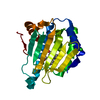
| ||||||||
|---|---|---|---|---|---|---|---|---|---|
| 1 |
| ||||||||
| Unit cell |
| ||||||||
| Components on special symmetry positions |
|
- Components
Components
| #1: Protein |  Heat shock response / Heat shock 86 kDa / HSP86 / Lipopolysaccharide-associated protein 2 / LPS-associated protein 2 / ...Heat shock 86 kDa / HSP86 / Lipopolysaccharide-associated protein 2 / LPS-associated protein 2 / Renal carcinoma antigen NY-REN-38 Heat shock response / Heat shock 86 kDa / HSP86 / Lipopolysaccharide-associated protein 2 / LPS-associated protein 2 / ...Heat shock 86 kDa / HSP86 / Lipopolysaccharide-associated protein 2 / LPS-associated protein 2 / Renal carcinoma antigen NY-REN-38Mass: 23392.516 Da / Num. of mol.: 1 Source method: isolated from a genetically manipulated source Source: (gene. exp.)   Homo sapiens (human) / Gene: HSP90AA1, HSP90A, HSPC1, HSPCA / Production host: Homo sapiens (human) / Gene: HSP90AA1, HSP90A, HSPC1, HSPCA / Production host:   Escherichia coli (E. coli) / References: UniProt: P07900 Escherichia coli (E. coli) / References: UniProt: P07900 | ||||||
|---|---|---|---|---|---|---|---|
| #2: Chemical | ChemComp-H9F /  Dipyridamole Dipyridamole | ||||||
| #3: Chemical |  Chloride Chloride#4: Chemical | #5: Water | ChemComp-HOH / |  Water WaterHas ligand of interest | Y | |
-Experimental details
-Experiment
| Experiment | Method:  X-RAY DIFFRACTION / Number of used crystals: 1 X-RAY DIFFRACTION / Number of used crystals: 1 |
|---|
- Sample preparation
Sample preparation
| Crystal | Density Matthews: 3.23 Å3/Da / Density % sol: 61.64 % |
|---|---|
Crystal grow | Temperature: 291 K / Method: vapor diffusion, hanging drop / Details: 0.1 M Tris pH8.7, 0.2M MgCl2, 22% PEG3350 |
-Data collection
| Diffraction | Mean temperature: 100 K / Serial crystal experiment: N |
|---|---|
| Diffraction source | Source:  SYNCHROTRON / Site: SYNCHROTRON / Site:  SSRF SSRF  / Beamline: BL19U1 / Wavelength: 0.97852 Å / Beamline: BL19U1 / Wavelength: 0.97852 Å |
| Detector | Type: DECTRIS PILATUS3 S 6M / Detector: PIXEL / Date: Nov 30, 2020 |
| Radiation | Protocol: SINGLE WAVELENGTH / Monochromatic (M) / Laue (L): M / Scattering type: x-ray |
| Radiation wavelength | Wavelength : 0.97852 Å / Relative weight: 1 : 0.97852 Å / Relative weight: 1 |
| Reflection | Resolution: 2.34→36.95 Å / Num. obs: 13286 / % possible obs: 97.4 % / Redundancy: 2 % / CC1/2: 1 / Rmerge(I) obs: 0.01 / Rrim(I) all: 0.013 / Net I/σ(I): 32.05 |
| Reflection shell | Resolution: 2.34→2.42 Å / Rmerge(I) obs: 0.06314 / Num. unique obs: 1344 / CC1/2: 0.988 / Rpim(I) all: 0.06314 / Rrim(I) all: 0.08929 |
- Processing
Processing
| Software |
| ||||||||||||||||||||||||||||||||||||||||||||||||||||||||||||
|---|---|---|---|---|---|---|---|---|---|---|---|---|---|---|---|---|---|---|---|---|---|---|---|---|---|---|---|---|---|---|---|---|---|---|---|---|---|---|---|---|---|---|---|---|---|---|---|---|---|---|---|---|---|---|---|---|---|---|---|---|---|
| Refinement | Method to determine structure : :  MOLECULAR REPLACEMENT MOLECULAR REPLACEMENTStarting model: 3T0H Resolution: 2.34→36.95 Å / Cor.coef. Fo:Fc: 0.943 / Cor.coef. Fo:Fc free: 0.916 / SU B: 6.104 / SU ML: 0.145 / Cross valid method: THROUGHOUT / σ(F): 0 / ESU R: 0.269 / ESU R Free: 0.217 / Stereochemistry target values: MAXIMUM LIKELIHOOD Details: HYDROGENS HAVE BEEN ADDED IN THE RIDING POSITIONS U VALUES : REFINED INDIVIDUALLY
| ||||||||||||||||||||||||||||||||||||||||||||||||||||||||||||
| Solvent computation | Ion probe radii: 0.8 Å / Shrinkage radii: 0.8 Å / VDW probe radii: 1.2 Å / Solvent model: MASK | ||||||||||||||||||||||||||||||||||||||||||||||||||||||||||||
| Displacement parameters | Biso max: 105.83 Å2 / Biso mean: 44.168 Å2 / Biso min: 25.7 Å2
| ||||||||||||||||||||||||||||||||||||||||||||||||||||||||||||
| Refinement step | Cycle: final / Resolution: 2.34→36.95 Å
| ||||||||||||||||||||||||||||||||||||||||||||||||||||||||||||
| Refine LS restraints |
| ||||||||||||||||||||||||||||||||||||||||||||||||||||||||||||
| LS refinement shell | Resolution: 2.34→2.4 Å / Rfactor Rfree error: 0
|
 Movie
Movie Controller
Controller



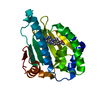
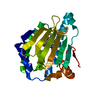
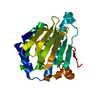
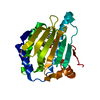
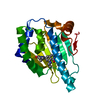
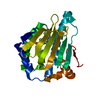
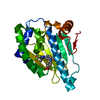
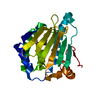
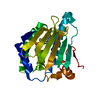
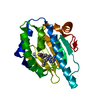

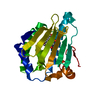
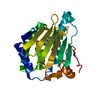
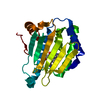
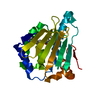
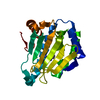
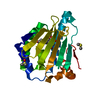
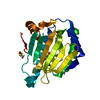
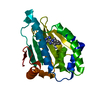
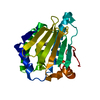
 PDBj
PDBj


























